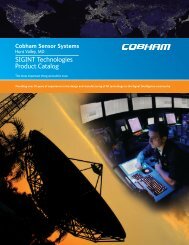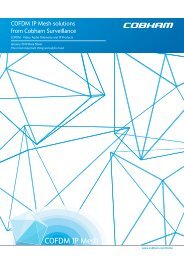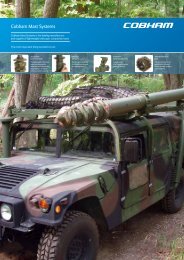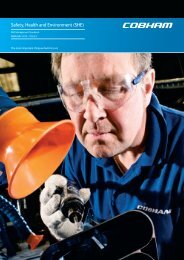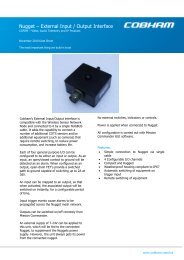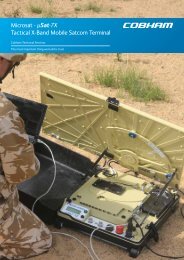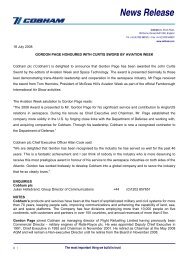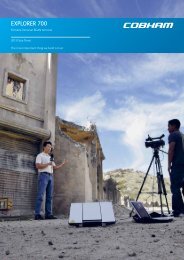installation an operation for sea tel model coastal 18 satellite tv ...
installation an operation for sea tel model coastal 18 satellite tv ...
installation an operation for sea tel model coastal 18 satellite tv ...
You also want an ePaper? Increase the reach of your titles
YUMPU automatically turns print PDFs into web optimized ePapers that Google loves.
Coastal <strong>18</strong> Ku-B<strong>an</strong>d TVRO Basic System In<strong>for</strong>mation<br />
3.3. Components of the System Configuration<br />
The following text provides a basic functional overview of the system components <strong>an</strong>d component<br />
interconnection as referred to in the System Block Diagram <strong>for</strong> your <strong>model</strong> <strong>an</strong>tenna (refer to the appropriate<br />
page which depicts your system configuration).<br />
The system is comprised of two major sections: The Above-Decks Equipment (ADE) is comprised solely of<br />
the <strong>an</strong>tenna radome assembly which is mounted outside, on the boats’ upper deck or mast location chosen<br />
<strong>for</strong> best sa<strong>tel</strong>lite reception. The Below-Decks Equipment (BDE) includes a matrix switch, the <strong>an</strong>tenna control<br />
p<strong>an</strong>el, sa<strong>tel</strong>lite receiver(s), TV set(s) <strong>an</strong>d all other <strong>an</strong>cillary equipment that is mounted in various locations<br />
throughout the interior of the boat.<br />
There will be <strong>an</strong> Antenna Control Cable between the ADE <strong>an</strong>d BDE. This cable supplies the operating<br />
voltage to the <strong>an</strong>tenna <strong>an</strong>d allows you to setup <strong>an</strong>d operate the <strong>an</strong>tenna from the Antenna Control P<strong>an</strong>el.<br />
The p<strong>an</strong>el also const<strong>an</strong>tly displays the status of the <strong>an</strong>tenna.<br />
Coax cables between the ADE <strong>an</strong>d BDE provide the received sa<strong>tel</strong>lite signals from the <strong>an</strong>tenna to the matrix<br />
switch. The matrix switch then distributes these sa<strong>tel</strong>lite signals to the sa<strong>tel</strong>lite receiver. The sa<strong>tel</strong>lite<br />
receivers convert the sa<strong>tel</strong>lite signals to provide audio <strong>an</strong>d video to your <strong>tel</strong>evision <strong>an</strong>d/or stereo.<br />
You will need to have 4 coaxes between the ADE <strong>an</strong>d BDE if you intend to have a Quad (4 output) LNB<br />
installed on your <strong>an</strong>tenna at <strong>an</strong>y point in time. Usage of this LNB is very popular in Europe.<br />
If you will only have a dual output LNB installed (linear or circular) you will only need to have 2 coaxes<br />
between the ADE <strong>an</strong>d BDE. Unused coax connections in the radome MUST be terminated (75 ohm<br />
terminators) if not used.<br />
3.3.1. Antenna Assembly<br />
The <strong>an</strong>tenna radome assembly consists of a sa<strong>tel</strong>lite <strong>an</strong>tenna <strong>an</strong>d a linear, or circular, Low Noise Block<br />
converter (LNB) with polarization motor mounted on a stabilized <strong>an</strong>tenna pedestal, housed inside a<br />
radome. The radome provides <strong>an</strong> environmental enclosure <strong>for</strong> the <strong>an</strong>tenna pedestal assembly inside it.<br />
This keeps wind, water condensation <strong>an</strong>d salt-water spray off the <strong>an</strong>tenna pedestal assembly. This<br />
prevents damage <strong>an</strong>d corrosion that would shorten the expected life sp<strong>an</strong> of the equipment.<br />
The <strong>an</strong>tenna control cable is connected between the <strong>an</strong>tenna radome assembly <strong>an</strong>d the <strong>an</strong>tenna control<br />
p<strong>an</strong>el. This cable provides DC voltage to the <strong>an</strong>tenna <strong>an</strong>d all control signals to <strong>an</strong>d from the <strong>an</strong>tenna.<br />
Two, or Four, RG-6 (or better) coax cables are connected from the <strong>an</strong>tenna radome assembly to the<br />
below decks equipment. These cables carry the intermediate frequency (950-2150MHz) signals from the<br />
<strong>an</strong>tenna assembly directly to a matrix switch (depending on the configuration), <strong>an</strong>d provide DC voltage<br />
<strong>an</strong>d tone switching to the LNB mounted on the <strong>an</strong>tenna. These cables ultima<strong>tel</strong>y provide the input signal<br />
into the sa<strong>tel</strong>lite receiver(s) from the matrix switch.<br />
3.3.2. Display Antenna Control P<strong>an</strong>el<br />
The <strong>an</strong>tenna control p<strong>an</strong>el allows the<br />
operator to control <strong>an</strong>d monitor the<br />
<strong>an</strong>tenna pedestal with simple dedicated<br />
function buttons, LED’s <strong>an</strong>d a 2 line<br />
display. The control p<strong>an</strong>el c<strong>an</strong> be<br />
surface mounted to <strong>an</strong>y convenient p<strong>an</strong>el<br />
location. It is recommended that the<br />
<strong>an</strong>tenna control p<strong>an</strong>el be mounted near<br />
one of the <strong>tel</strong>evision locations where you<br />
c<strong>an</strong> see the <strong>tel</strong>evision screen while you<br />
are controlling the <strong>an</strong>tenna.<br />
The <strong>an</strong>tenna control p<strong>an</strong>el is connected<br />
to the <strong>an</strong>tenna <strong>an</strong>d to the +12 VDC<br />
power supply.<br />
3-5<br />
Figure 3-2 Antenna Control P<strong>an</strong>el




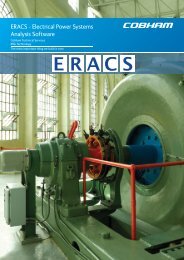
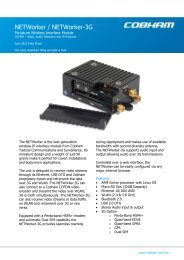
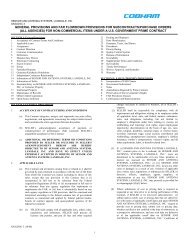
![NC1147 (pdf 1.47 mb) Nitrogen Concentrator [OBIGGS] - Cobham plc](https://img.yumpu.com/51124104/1/190x245/nc1147-pdf-147-mb-nitrogen-concentrator-obiggs-cobham-plc.jpg?quality=85)
